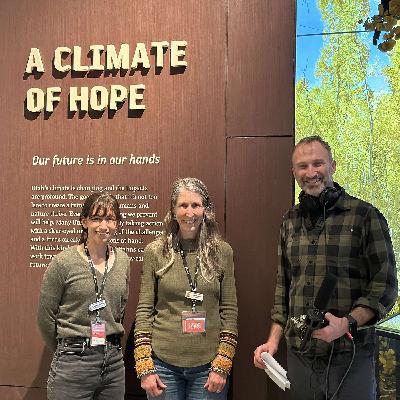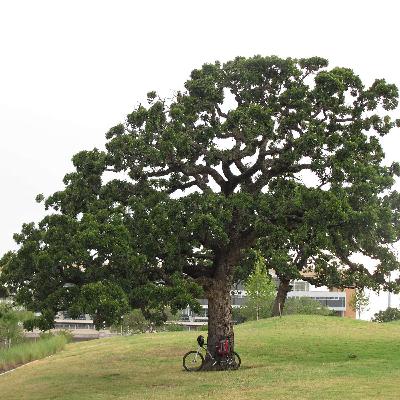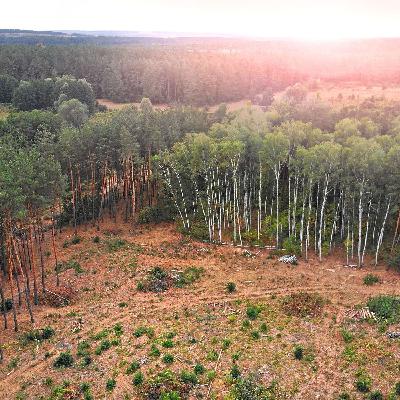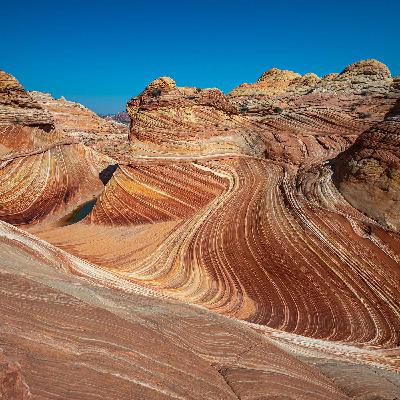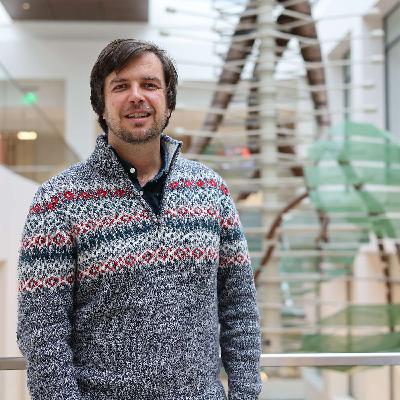Discover Talking Climate
Talking Climate

29 Episodes
Reverse
When it comes to climate change, one big question is how are ecosystems adapting to shifting weather patterns, heavier precipitation events, and hotter temperatures for longer periods of time? Are some plants better equipped to withstand these changes than others? And if yes, then why and how? Jacob Levine is a Wilkes Center Postdoctoral scholar here at the University of Utah. He is interested in how climate change is impacting plant ecosystems. Specifically, whe...
The Wilkes Center recently hosted its 3rd annual climate solutions hackathon at the end of January. This year the focus was water resources. The “hackathon” as we’ve come to call it – borrowing the term from the computer coding world – is an intense problem-solving competition where we challenge U of U undergraduate and graduate students from any discipline to team-up and develop proposals in a slide deck within 24 hours. We asked students to propose an innovative, data-driven solution ...
Perovskites are crystal structures that can be manufactured in labs for making solar panels. They are relatively cost-effective, and efficient, and could provide a reliable thin-film alternative to the more common silicon-based solar panels. However, perovskite solar cells face a few challenges that must be addressed before they can become a competitive commercial PV technology. In some forms they can be unstable, and lead can be a toxic byproduct when processing them. And yet, p...
There are an estimated 54,000 glaciers in the Hindu Kush Himalayas. These glaciers cover 60,000 square kilometers and serve as a major source of the water in the region’s rivers, including as much as 40 percent in the Indus River system - the backbone of agriculture and food production in Pakistan, for example. But in recent decades glaciologists – those who study glaciers – are concerned with how fast Himalayan glaciers are melting, and what that could mean for the more than a billion people...
It’s true the Earth has experienced periods of global warming in its past. The largest such warming event in the past 90 million years - since the time dinosaurs roamed Earth - was the Paleocene–Eocene Thermal Maximum, about 56 million years ago. Average global temperatures increased by 4–5°C over a period of 3,000–10,000 years. Human beings were definitely not walking the Earth back then, but today scientists are able to piece together evidence of how and why this ancient g...
"Eco-anxiety" or "Climate grief" are increasingly part of our lexicon when it comes to describing the heavy feelings of concern people are feeling about the state of our natural environment and global climate change. This past year, Jennifer Follstad Shah, associate professor in the School of the Environment, Society and Sustainability, along with her colleague Andrea Brunelle, and other co-PIs on the project including Adrienne Cachelin, Monika Lohani, Sara Yeo, and Lynne Zummo conducted a st...
Dr. Jon Wang, an Assistant Professor in the School of Biological Sciences here at the U, manages the Dynamic Carbon and Ecosystems Lab, or DYCE Lab. He has access to high-resolution airborne laser scanning data to map forests across the world to measure to set benchmarks for that data and monitor for changes. Wang is interested in how climate change and human activity are rapidly transforming terrestrial ecosystems such as with wildfire, timber harvest, urbanization, and drought.&...
In September this year, the Wilkes Center for Climate Science and Policy awarded Applied Carbon, the climate tech company based in Houston, Texas, the $500,000 Wilkes Climate Launch Prize. Applied Carbon, formerly Climate Robotics, is a technology company designing automated biochar production machines that convert in-field agricultural crop waste into biochar. Jason Aramburu, who is a Co-founder and CEO of the company, has researched biochar since he was an undergraduate student at Princeton...
Austin Green is a postdoctoral researcher in the Department of Biology with the College of Science’s Science Research Initiative, or SRI program. His specialty is using camera traps to monitor and capture image data of wildlife in wilderness areas. His research involves gathering this data to study wild animal behavior, their movement patterns, and how human behavior is impacting wildlife. Some of his research has suggested that climate change is making life harder for wildlife to adapt...
If you’ve taken a hike or a drive through northern Utah’s forests recently, you may have noticed that some areas of the forests are changing and looking a little sick. Northern Utah’s forests are increasingly experiencing an infestation of a tiny non-native insect called balsam woolly adelgid (or BWA), that’s slowly attacking subalpine fir which are among the most common conifers in the Wasatch Mountains. Dr. Mickey Campbell was the lead author of a recently published study that maps th...
For this episode we talk with Dr. Marie Jackson a Research Professor in the Geology & Geophysics department here at the University of Utah. Dr. Jackson’s work is centered in mineralogy, pyroclastic volcanism, and material science, but she applies her work to the realms of engineering, archeology, and more. She’s done a lot of pioneering work on understanding ancient Roman concrete, their composition, structure and how they age over time. Working to make a modern proxy of the concrete has ...
Zoe Exelbert studies birds at the Great Salt Lake. Specifically, she’s interested in how climate change and shifting weather patterns are affecting bird migrations and in turn, how this is impacting the overall ecosystem of Great Salt Lake. Exelbert is a Data Science and environmental studies undergraduate student here at the U. She says understanding the ways these migratory birds are changing their behaviors could be indicative of how we as human are also changing -- and may continue ...
The new Climate of Hope exhibit at the Natural History Museum of Utah offers museum visitors a more localized and solutions-oriented framing of climate change than other exhibits have done in past years. In this episode, exhibit developer Lisa Thompson and Lynne Zummo, the curator of Learning Sciences at NHMU, take us through the interactive exhibit where they are gathering important data that may improve communication techniques and strategies in years to come. wilkescenter.utah.edu/podcast/...
For this episode we talk with Dr. Alexandra Ponette-Gonzalez, an Associate Professor in the Department of City and Metropolitan Planning and Curator of Urban ecology at the Natural History Museum of Utah. Ponette-Gonzalez’s work focuses primarily on urban ecology. She studies forests and trees and how they interact with the atmosphere and urban environments. She’s done a lot of cutting edge research on things like urban ecology, urban black carbon, and what happens to smoke and du...
The Wilkes Center held its second annual Climate Solutions Hackathon on January 26th. This was not a coding “hackathon” but a competition to find innovative solutions to the daunting challenges of climate change-driven wildfires. U students were asked to form teams, choose one of five themes to focus their solution, and accomplish this in 24 hours. Ultimately, the Wilkes Center received a total of 17 submissions, with 3 teams winning the top prizes. In this episode I share m...
Listeners to the podcast are very likely familiar with the concept of carbon offsetting or carbon credits. This is the idea that a company that pollutes in the course of its business practice can purchase carbon credits, often in the form of supporting tree planting somewhere in the world, with a promise that doing this will remove carbon dioxide from the atmosphere, to “offset” or balance-out the company’s carbon pollution. This has become a billion-dollar global market. But in ...
One of the many challenges facing the world in the coming decades to reach carbon neutrality - in order for climate change to stabilize – is the challenge of both capturing and sequestering carbon dioxide that is emitted from power plants and putting it underground. This is what is called Carbon Capture Utilization and Storage. And accomplishing this on a large scale will be necessary all across the world to meet carbon emissions reduction goals laid out by the Paris Climate Agreement. ...
Understanding how volatile organic compounds (VOCs) that originate from living organisms like trees and plants could influence climate change and air pollution is an important area of research. Recently I had the opportunity to sit down and talk with Alfred Mayhew, who is postdoctoral researcher in the Department of Atmospheric Sciences here at the U. Alfred did his earlier graduate and PHD work at the University of York in the UK. Dr. Mayhew’s research is focus...
What does it take for whole cities to take the actions necessary to adapt to a changing climate? What is required for millions of people who live in the same metropolis to agree to certain changes to become resilient to climate change-driven natural disasters? These are the questions that Malcolm Araos has been asking. Malcolm Araos is a Wilkes Center post-doctoral student in the Department of Geography. Previously Araos, who is originally from Canada, was a PhD student in Sociology at ...
As scientists, policymakers, and other environmentally-concerned individuals search for solutions to the changing climate, glaciers are an important topic. With the ability to both study glaciers in their current states, and use geomorphology and numerical modeling to understand the historical placements of glaciers in the past, they hold clues for interpreting the climate. Dr. Leif Anderson has been studying glaciers since the completion of his undergraduate degree at Montana State Universit...














